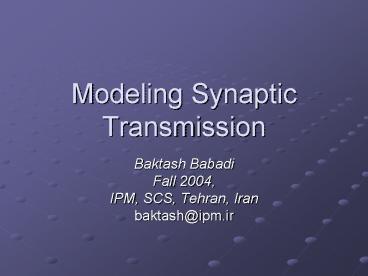Modeling Synaptic Transmission PowerPoint PPT Presentation
1 / 22
Title: Modeling Synaptic Transmission
1
Modeling Synaptic Transmission
- Baktash Babadi
- Fall 2004,
- IPM, SCS, Tehran, Iran
- baktash_at_ipm.ir
2
The Synapses
3
What Happens in a Synapse?
Ca
Ca
Ca
Ca
4
Stages of Modeling
- Dynamics of Calcium Ion
- Probability of Transmitter Release
- Kinetics of Receptor Binding
- Kinetics of Channel Opening
5
The General Framework
6
Quantal Release
- Each Synapse has a number of independent release
sites (N) - Each site releases no or a single vesicle
- If the probability of release for each site is
prel, the number of released vesicles obeys
7
Modeling Transmitter Release
- Assumptions
- Upon release, the transmitter diffuses very
rapidly in the synaptic cleft (nanoseconds) - Given the narrowness of the synaptic cleft, the
transmitter concentration will be high at the
cleft after release - The transmitter will be washed out quickly from
the cleft by a number of mechanisms (pre-synaptic
uptake, extra cellular enzymes, diffusion,)
- Thus the transmitter concentration in synaptic
cleft after release can be modeled as a square
pulse
T
t0 trel
8
Synaptic Channel Gating (1)
ßS
aS
T
PS
1-PS
9
Synaptic Channel Gating (2)
10
Synaptic Channel Gating (3)
- Experimental fit to mossy fibers input to
hippocampus CA3 region
11
Synaptic Channel Gating (4)
- Single exponential Synapse (for fast synapses)
12
Synaptic Channel Gating (5)
- Double exponential Synapse (for slower synapses)
13
Synaptic Channel Gating (6)
- Alpha Synapse (for slower synapses)
14
Synaptic Weight
- Synaptic current is generally modeled as
Constant
Between 0 and 1
15
Inhibitory/Excitatory
- Post Synaptic Current (PSC)
- A synapse is excitatory if the post synaptic
current is inward (influx of positive ions) - A synapse is inhibitory if the post synaptic
current is outward (influx of negative
ions/efflux of positive ions) - Post Synaptic Potential (PSP)
- A synapse is excitatory if it tends to depolarize
the membrane (EPSP) - A synapse is inhibitory if it tends to
hyper-polarize the membrane (IPSP)
16
Classification of Synapses
- Ionotropic
- Metabotropic
17
The most common Synapses
- Glutamine ( Excitatory) (Asymmetric/Type I)
- AMPA Synapse (Fast)
- NMDA Synapse (Slow)
- GABA (- Inhibitory) (Symmetric/Type II)
- GABA A Synapse (Fast)
- GABA B Synapse (Slow)
18
AMPA Synapse
19
NMDA Synapse
20
NMDA Synapse (2)
21
GABA A Synapse
22
GABA B Synapse

